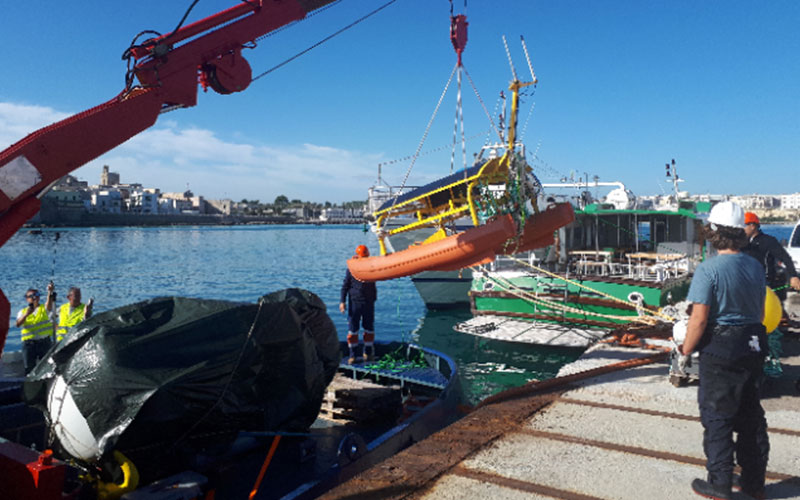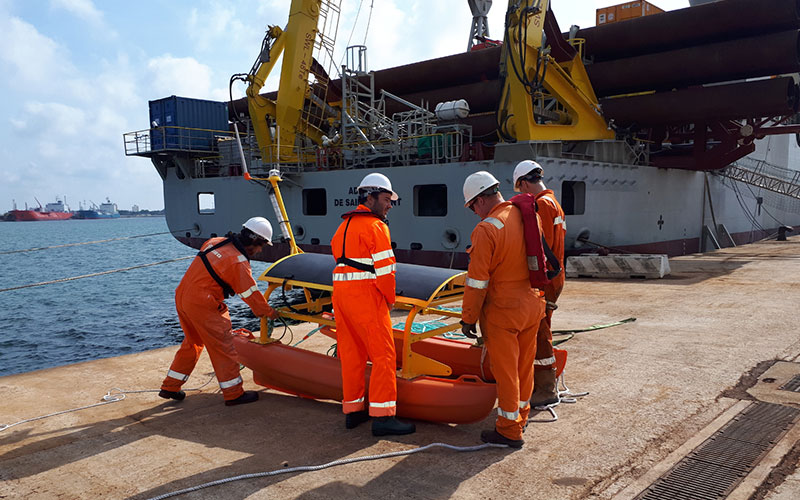Environmental impact studies, risk management in harbours, fishing optimisation, scientific modelling, simulation and experimentation, risk evaluations for navigation… SINAY, created in 2008, developed the first big data platform covering multiple maritime activities just some three years ago. Also a member of the consortium of businesses involved in the project SMART PORT CITY, being developed by the port of Le Havre, this Normandy SME offers unique expertise in both the digital and maritime sectors and is continuing to expand internationally. Its story.
Experience in the field to change things for the better
A Norman SME created in Caen some 11 years plus ago, SINAY is today a specialist in both digital data and maritime matters. At the start, the company was focused on the issue of passive acoustics, that’s to say the study of underwater sounds, combined with the study of fishing: ‘‘Human activities produce noise and we know that marine mammals themselves move around using sonar signals emitting noise, sometimes creating interference,’’ explains Stéphane Alain Riou, VP of Sales and Marketing. Now, measuring underwater acoustics requires recording underwater noises with a hydrophone (or underwater microphone), which involves collecting very large volumes of data: ‘‘Our engineers found that they weren’t able to deal in an efficient way with the volumes of data using traditional methods of calculation, so they had the idea of using big data.’’
We certainly weren’t the only ones interested in a certain number of algorithms
Three years ago, the SME, which employs 50 people, therefore decided on a very important first shift, into developing the first-ever maritime big data platform. The idea behind it? ‘‘We realised that in lots of industries linked to the sea, there were also very large volumes of raw data being registered, for instance by sensors in factories or on boats… Now, it’s extremely interesting to carry out automatic calculations on such data, in order to extract indicators on how to carry out one’s activity in the best way possible,’’ asserts Stéphane Alain Riou. By way of example, consider how, by combining many lots of data, such as on the strength of currents and winds and on engine fuel consumption, it’s then possible for a boat to decide on the best possible maritime route and to save on fuel… ‘‘We don’t go about making these calculations in an intuitive manner, but in a reasoned one, learning from past experience and a combination of measurements that allow us to come up with real practical indications.’’
With maritime matters, you always need [to know about] the tide, the current, the weather, the sea traffic… necessary calculations that always crop up in the same way
One platform, three major components
There are three major components to the company’s big data platform: first, an enormous database, enriched and updated daily, that contains, at present, over 6,000 maritime datasets taken from across the whole world. ‘‘For example, we’re connected to a network of 35,000 surveillance buoys measuring the quality of sea water. We’re able to connect, via this network, to the seas around Singapore, the island of La Réunion… or the port of Cherbourg!’’ And hence to gather, in real time, precious information, for example on the salinity, temperature and quality of the given water. The second essential component is artificial intelligence and the writing of algorithms enabling the automatic treatment of the datasets. This allows the company’s data scientists to analyse, store and make these datasets secure, and to put them in the correct format to then code them, enabling automatic data processing.
Besides its database and its catalogue of algorithms, SINAY is also developing applications, the third component in its big data platform. Applications adapted to respond precisely to clients’ needs and questions. ‘‘It could simply be, for example, a dashboard to visualise all the data clients collect daily in their activities,’’ notes Stéphane Alain Riou, or then environmental monitoring, in the case of maritime works, or alerts in real time, risk analyses, etc. The company is also capable of developing profession-specific applications. ‘‘We have, for example, prepared an application for submarine cables used for the internet and telecommunications. According to factors such as the weather, maritime traffic, depth, and so on, we can calculate the probability of a cable being severed or not by a passing cargo ship or trawler.’’ A very useful application when you realise that 98% of internet transactions pass via over 1 million kilometres of submarine cables laid around the world’s oceans and seas!
Over ten years, the company can count over 6,000 days at sea behind it, something that gives us credibility. We know what it’s all about and we speak the same language as our clients
A Norman SME that’s going transatlantic
Whether it concern offshore activities and cables, ports and maritime works, fishing and fisheries, renewable marine energies or naval industries, ‘’the challenge we’ve given ourselves is to adapt to the specificities of maritime matters. We come from that world, which allows us to offer up our dual skills,’’ asserts Stéphane Alain Riou. Subsidised by the French government via ADEME (l’Agence de l’environnement et de la maîtrise de l’énergie, France’s Agency for the Environment and Energy Management), recognised by the European Commission with a seal of excellence and certified OHS18001 (a security norm in the IT sphere), SINAY’s big data platform is continuing to evolve. If some 15 or so other companies around the world can offer certain similar services, our Normandy company is, for the time being, the only one on the planet able to provide such complete, sophisticated solutions geared to the whole range of professionals involved with the sea.
An innovation which is enabling it, now, to grow its activities, creating a subsidiary in California to serve the American and Canadian markets. ‘‘The maritime sector represents over 70% of export turnover today; when you start selling a solution [in this field], you quickly acquire an international market. The latest studies on data linked to maritime matters forecast a market that’s set to grow 30% a year in the next four years.’’ This rate of increase is linked to the sustained, progressive digitalisation society is undergoing, with the maritime sector no exception, a fact that is enabling the company to recruit: ‘‘We have 50 staff members at present, divided up between Caen, Brittany and PACA [the Provence Alpes Côte d’Azur Region]. We’re in search of professionals with varied profiles, such as IT developers, data scientists and people who possess those dual skills, to be able to work in both digital and scientific spheres.’’
SINAY and the SMART PORT CITY project: ‘‘The port of Le Havre is, along with Marseille, one of the two French ports known on the international scene. As Normans, we’re interested in the process to develop digitalisation linking Le Havre’s port activities to the town via the SMART PORT CITY project! It will also allow us to test out new solutions with partners working within the orbit of the port of Le Havre. For example, we’re working on a Proof of Concept, or PoC [a kind of feasibility study], on the town’s air quality and in particular on the optimisation of the future network for measuring the quality of the air in the port. We take into account historical data, along with the weather, road traffic and maritime traffic… The aim is to draw overarching rules that will allow the port to set up a monitoring network that’s both suitable and specific.’’
Good to know
Encompassing ‘the smart city’ and ‘the port of the future’, the SMART PORT CITY project aims to bring about a profound transformation of Le Havre’s urban area through innovation that will have an impact at both national and European level.
Smart Port City is based on three principal lines of action: the bringing about of a technological transition that could serve as a world reference in how to create a high-performance logistics economy; the creation of an exemplary, innovative region, environmentally speaking, covering the Seine Estuary; and the construction of a city-port interface, a laboratory testing out new ways of operating in both city and port…
The project is supported by Le Havre Seine Métropole, HAROPA-Port du Havre, the Université Le Havre Normandie, Synerzip LH and their partners… and it figures among the 24 award-winners in the 2018 Programme National des Investissements d’Avenir (PIA 3) – or National Programme for Investing for the Future –, under the category ‘Territoire d’innovation de grande ambition’ (or ‘Region focused on major ambitious innovations’).


